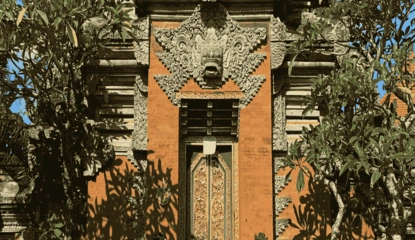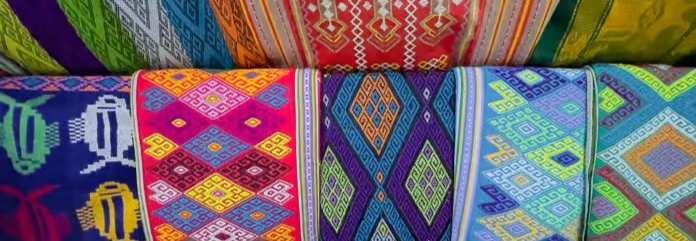Indonesia’s traditional fabrics, with intricate designs and vibrant colors, are deeply tied to the country’s diverse heritage. From ceremonial garb to high-end fashion, each fabric carries stories and traditions unique to its place of origin. Here’s an exploration of six distinctive fabrics from across Indonesia, including what makes them special, price insights, and tips on where to find these authentic pieces.
1. Kain Cual – A Coastal Gem from Bangka Belitung
Photo credit: indonesiakaya.com
Originating in the Bangka Belitung Islands, Kain Cual resembles the Malay Songket but features its own local motifs inspired by marine life and flowers. The fabric, traditionally called Limar Mentok, is woven using cotton, silk, and often gold threads, giving it a unique texture and luxurious appeal. It has been a cultural staple since the 17th century, primarily used for ceremonial attire.
- Unique Features: Local artisans incorporate detailed sea animal and floral patterns, and some designs show influences from other cultures, such as motifs with ducks or stars.
- Pricing: Cual’s prices vary widely, from IDR 50,000 (about USD 3.20) for basic pieces to IDR 15,000,000 (USD 960) for premium silk or gold-threaded versions.
- Tips for Visiting: Bangka Belitung hosts various craft markets where you can find authentic Cual fabrics. To witness the weaving process, consider visiting traditional workshops in Mentok.
2. Kain Sasirangan – The Healer Cloth of South Kalimantan
Photo credit: instagram.com
This vibrant fabric from South Kalimantan’s Banjar people dates back to the 12th century and has unique dye patterns created using the “jelujur” (running stitch) technique. Sasirangan was once believed to have protective powers, reserved for special occasions and rituals, but today it is widely accessible.
- Unique Features: Patterns often reflect natural elements from Kalimantan, including plant and river motifs. The fabric is colorful, with shades that symbolize different blessings.
- Pricing: Starting around IDR 50,000 (USD 3.20) for simple designs, Sasirangan can cost up to several hundred dollars depending on the intricacy
- Tips for Visiting: Sasirangan workshops in Banjarmasin offer hands-on experiences where you can learn about the dyeing process. Be sure to visit in the morning when workshops are active.
3. Songket – The Opulent Weave of Sumatra
Known as the "Queen of Indonesian Fabrics," Songket is a hand-woven textile originating in Sumatra and used widely throughout Southeast Asia. This luxurious fabric, interwoven with metallic threads, was historically linked to the Sriwijaya Kingdom and has been a symbol of nobility and prosperity.
- Unique Features: Sumatra’s songket motifs, such as Bintang Berante and Naga Besaung, are rich with symbolism and are often gifted as dowries.
- Pricing: Prices range from IDR 150,000 (USD 9.60) for simpler cotton-based pieces to IDR 10,000,000 (USD 640) or more for elaborate gold-threaded designs.
- Tips for Visiting: To find the best pieces, visit Palembang and Minangkabau in Sumatra, especially during traditional festivals when songket attire is prominently showcased.
4. Ulos – The Sacred Fabric of the Batak People
Photo credit: instagram.com
Hailing from North Sumatra, Ulos holds a significant place in Batak culture and is often used in ceremonies marking life’s major events, from births to weddings. Woven with red, black, and white threads, the patterns on Ulos symbolize warmth, love, and protection.
- Unique Features: Designs like Ulos Ragidup and Ulos Ragi Hotang are reserved for specific ceremonial contexts, each carrying distinct spiritual meanings.
- Pricing: Prices range from IDR 100,000 (USD 6.40) for everyday items to IDR 5,000,000 (USD 320) for intricate pieces made with gold threads.
- Tips for Visiting: The Lake Toba area offers traditional shops and markets where you can see artisans weaving Ulos. It’s also worth exploring the region’s scenic beauty.
5. Tenun Ikat – The Diverse Weave of Eastern Indonesia
Photo credit: traverse.id
Tenun Ikat, known for its tied-dye weaving technique, is produced in regions like Sumba, Flores, and Timor. This craft combines vibrant natural dyes with detailed, hand-tied patterns, making each piece unique. The technique is influenced by Chinese, Indian, and Persian cultures, highlighting Indonesia’s historical trade connections.
- Unique Features: Designs vary widely, from geometric shapes in Sumba to floral patterns in Flores, with each motif symbolizing a part of the local identity.
- Pricing: Expect prices from IDR 100,000 (USD 6.40) for smaller pieces to IDR 10,000,000 (USD 640) for larger, meticulously crafted textiles.
- Tips for Visiting: Visiting Sumba or Flores? Seek out Tenun Ikat artisans in rural villages for the most authentic experience. Local markets also offer stunning souvenirs and wearable ikat items.
6. Batik – Indonesia’s UNESCO-Honored Textile
Recognized by UNESCO, Batik is synonymous with Javanese culture, with patterns that reflect deep philosophical meanings. Produced in regions like Yogyakarta, Solo, and Pekalongan, each area’s Batik style has its own characteristic motifs—from Yogyakarta’s Parang to Pekalongan’s pesisiran (coastal) designs.
- Unique Features: Batik patterns use “canting” tools to apply hot wax in detailed designs before dyeing, resulting in intricate, layered patterns.
- Pricing: Printed Batik is affordable at around IDR 50,000 (USD 3.20), while hand-drawn Batik Tulis pieces range from IDR 300,000 (USD 19) to over IDR 5,000,000 (USD 320).
- Tips for Visiting: Visit the Yogyakarta Batik Museum to see traditional tools and batik-making demonstrations. If you’re in Pekalongan, the Batik Museum there offers a more coastal perspective on this iconic fabric.
Indonesia’s diverse textiles are more than just fabric—they’re a gateway into the nation’s cultural tapestry, connecting tradition, art, and heritage. From the intricate golden threads of Songket to the soulful, hand-dyed Sasirangan of Borneo, each type of traditional cloth offers a unique glimpse into the lives, beliefs, and creativity of local artisans. These textiles, often crafted with painstaking detail and layered with history, bring Indonesia’s rich cultural legacy into the modern age, letting travelers take home a piece of its story.
As you explore Indonesia, consider taking a guided tour through local weaving villages, where artisans still practice time-honored methods, or plan a visit to a heritage museum to deepen your appreciation for these captivating textiles. Whether you’re looking to add a stunning piece to your wardrobe or simply want to immerse yourself in the vibrant colors and patterns of Indonesian culture, the allure of these fabrics is bound to enchant you.
Don’t miss out on discovering more about #WonderfulIndonesia by following @wonderfulindonesia on Instagram for breathtaking destinations and experiences. Embrace the adventure and let Indonesia inspire your next travel story!







